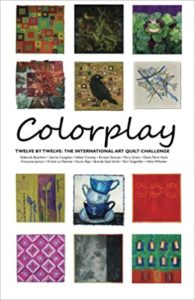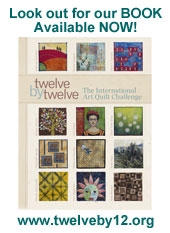I have to admit, sometimes the mathematical premise behind my quilt makes some sense and other times I just can't get my head around it. Sadly, today is one of the later. My head is already starting to hurt, as so many of you have already expressed as a common reaction to higher math.
The imagery comes from Fourier Series and phasor vectors. The idea is relatively simple sine waves are added together in different phases to form more complex curves. These can be expressed with mathematical equations, or visually in a complex plane or periodic signal. I used the website Phasor Phactory to create visuals for one of these complex waves. The large image is the wave on the complex plane. The quilting lines are the periodic signal of the same wave. This is definitely a case where an artist rendering is much easier to understand than the mathematical explanation!
I did a lot of firsts for me with this quilt. I used traditional piecing for the background quadrants, but then fused the shapes within the curves. I also fused shears where the outline of the curve made a loop. I then used free motion zigzag to follow the line of the curve. Finally I did precision quilting to follow the exact periodic signal of the wave. I'm not one who usually follows a pattern--I tend to be very loose in my quilting--so sticking to the lines was rather difficult. My first attempt was awful, so I ended up redoing the whole quilt. I tried to use a plastic film as a guild, which I stitched over. In my test, it perforated fine and I was able to pull out the pieces. The problem was the tension was a mess with more bobbin than top thread showing. I solved the problem the second time by using water soluble stabilizer and the same bobbin and top thread. Here is a close up of the stitching so you can follow the lines of the curve.





15 comments:
Nikki, this piece is simple and so complex, I have been studying it for several minutes, and I keep seeing new patterns. I agree this should be the start of a series. The stitching is really interesting to me, sort of meandering, but not. I really like it.
I love the quilting and am impressed that you followed a precise pattern. The color is a surprise and very appealing to me. I will not pretend to even understand the math behind it!!! I appreciate the thought you put into it and it's execution. Who knew that complex math could be beautiful.
This is quite fascinating. I have to admit that when I first saw the picture, I thought, what lovely colors and what graceful curls. Then I read your mathematical explanation and thought, what lovely colors and what graceful curls!
I guess what I mean is that even with the impressive mathematical source, the design is very pleasing. And it's fascinating to think that swirly shapes like this can have a mathematical explanation.
So now when my daughter asks WHY she will need math, I will add to my list of answers that it will help her make beautiful curly shapes.
Excellent response to the theme! Was your husband impressed at the way you responded to his formula?!
I had no idea that the equation you posted earlier could be this pretty. I agree that it would be interesting to make a series in which a part of the equation is altered slightly in each one. It would be fun to see how the loops/curves are affected. I'm impressed with your periodic signal quilting too!
I'm amazed at the different curves that can be created, including right angles and zig zags.
Beautiful. As Karen said, it's fantastically simple and complex at the same time. I also am very impressed by the background quilting knowing what it actually means. Wow. I also think the use of sheers is really brilliant. It adds a lot of dimension to the piece.
I forget, until I see something like this, how graphic and wonderful visual expressions of mathematical concepts can be. Are you familiar with the books of Martin Gardner? I always loved the very graphic math puzzles and games that he came up with.
The use of color here is beautiful. A series could be stunning!
OK. I read your post. Then I re-read it. Then I went away and came back and re-read it. There are some words I undererstand like 'and' and ' water soluble' and 'stitching'. Otherwise what I get is that you are a smart, smart woman and creatively talented too. Wow!
I'm not familiar with Martin Gardner -- I'll have to check it out.
Helen -- I'm sure there are a few more words like waves (think of relaxing on the beach). If you go to the Phasor Phactory website you too can create complex waves. Just change the number in the box marked harmonics and hit play. Don't even try to read the math. If you're really brave you can change the choice on the left side and hit play. (I know, I better watch out or you'll have us interpreting the law code in a few months)
Ha ha! Helen, I felt the same way! All I know is, I like it! I don't understand it, but I like it :)
Nikki, the quilt is a really nice touch!
Whoops - the quilTING is a nice touch.
Trans...what????? Have to admit, I can't wrap anything around that one Nikki! But I love your curvy design and the colors are fabulous.
This project is all about exploration and experimentation. Your choice of theme seems to have inspired all of us to try different things that we will be able to incorporate into further works. My curves in Simple String Theory are not as adventurous as yours but I'm sure will be a platform for similar quilts in a larger format.
Your use of a limited palette is very effective and your background quilting is sublime. A Transcendental series sounds like a great idea!
Brilliant!
I really love the background quilting. I'm a bit surprised by the choice of colour but I like it.
What a great work. I love the colours and the design. I also like the way you quilted it. It adds to your design and gives it motion.
Post a Comment